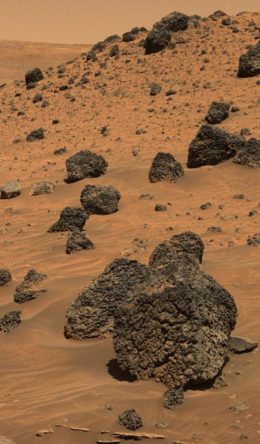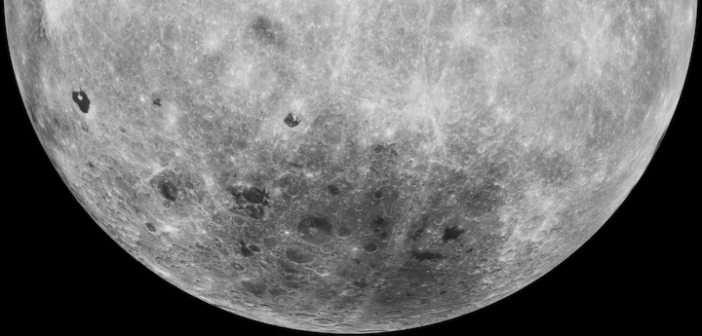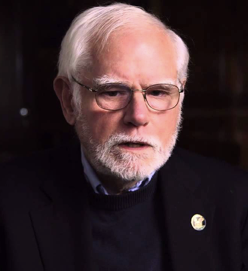The 234th meeting of the American Astronomical Society will take place June 9–13 in St. Louis, MO. In advance of the meeting, Astrobites authors have conducted interviews with some of the meeting’s keynote speakers to learn more about their research and careers. We’ll be publishing those interviews here over the coming days as part of our #AAS234 series!
Professor James Head III (interviewed by Emma Foxell)
“Our job is to think our way to the Moon and back.” These were the twelve words on the job advert that changed the course of Prof. Jim Head’s career. This was 1968 and, armed with a PhD in geology, Head joined the Apollo space program to help realise President Kennedy’s dream of sending humans to the Moon.
James Head III is the Louis and Elizabeth Scherck Distinguished Professor in the Department of Earth, Environmental and Planetary Sciences at Brown University. Growing up in Washington, D.C. in the 1940s and 50s, Head was always looking at the ground, fascinated by the rocks beneath our feet. This led him to study geology at both undergraduate and graduate levels. However, this was the era of the Space Race and something caused him to look up. In 1957, with his “internet” (actually a shortwave radio), he used the timings sent by Radio Moscow to hear the characteristic “beep, beep, beep” that signalled the first manmade satellite, Sputnik 1, passing overhead.
Another major influence on Head’s career was one of his professors in grad school. This “far-thinking” professor taught a course on remote sensing techniques, allowing them to apply what they had learnt about geology on Earth to look at other planets. After gaining his PhD from Brown University, Head was looking through the university’s job catalog, where he came across that influential job advert.
While the primary goal of Apollo was to send people to the Moon, those working on the missions realised the scientific opportunity. Working for NASA, Head helped select landing sites for the Apollo missions that maximized both safety and scientific merit. He trained (and continues to train) astronauts in geological techniques and surface exploration. He helped select experiments for the Moon and analysed the returned lunar samples. While the Earth has evolved due to its dynamic atmosphere, oceans and continents, the barren, airless Moon is comparatively preserved, allowing geologists to study the formative years on the Moon and fill in the missing record on Earth.

Figure 1: An example of an irregular mare patch, a depression within the lunar mare (the dark, flat planes mistakenly identified as seas by early astronomers). [NASA/GSFC/Arizona State University]
Current and Future Exploration of the Moon
After working at NASA, Prof. Head returned to Brown University. He continues to work on both lunar and planetary geology. He is involved with the Lunar Reconnaissance Orbiter (LRO) mission, launched as part of President Bush’s vision to go back to the Moon. The LRO has been surveying the Moon for nearly 10 years, gathering data on its topography and mineralogy. The LRO’s Lunar Orbiter Laser Altimeter uses a laser to bounce light off the Moon, timing how long the echo takes to measure the height of the Moon’s surface. The topographical data it collects can be used both for identifying landing sites and to inform our understanding of the Moon’s geological past. A surprising result from the LRO is the presence of small and pesky to explain irregular mare patches (IMPs) — unusual depressions, often with mounds, on the Moon’s surface. Some geologists have hypothesised that IMPs are incredibly young, perhaps under 100 million years old. If they are due to volcanic activity, this would mean rewriting our understanding of the Moon (as volcanic activity was believed to have ceased 1 billion years ago).
One place that Head would like to explore further is the South Pole Aitken Basin, caused by the oldest known impact on the Moon. This provides a ready-made drill hole, allowing us to sample the mantle below the Moon’s crust and date the material. This is the landing site of Chang’e 4, the first mission to land (rather than crash) on the far side of the Moon, and part of the Chinese series of missions that Head has helped advise on. A future possible mission, Chang’e 6, may return a sample from this region.
While some believe that the next destination of human space exploration should be an asteroid or Mars, Head quotes the Apollo astronauts as saying, “We made going to the Moon look too easy.” He believes that the Moon would act as a good training base for astronauts on missions to Mars. Head explains, “We took the Apollo astronauts out to different places on the Earth’s surface, from Hawaii to Iceland, all over the world to train them in different geology. The next wave of astronauts will go to the Moon to learn how to do activities as they are training to go to Mars.” Training on the Moon would allow us to learn how to explore another world again just a few days’ space travel from the safety of Earth, before committing to the hundreds of days required to reach Mars.

This scene from the Spirit rover captures volcanic-looking rocks strewn across Mars’s surface. Can we learn about these by studying rocks in Antarctica? [Mars Exploration Rover Mission/Cornell/JPL/NASA]
Advice for Students
What advice does Head have for students about to start their careers? “Don’t be afraid to leap into the not very well known,” he says, and to seize an opportunity even if it seems beyond your capability. He points out that we do not know everything, that “none of us were qualified to plan the lunar landings,” and reassures us that “it is okay to have a non-linear career path.”
More generally, Head is an advocate for daydreaming — difficult in this age of iPhones and distractions, but it’s “really important to let the mind make seemingly random associations.” He suggests to plan your day to prevent letting the schedule of others stop you from doing what is most important. And finally, be “passionate about what you do.”
Find out more at Professor James Head III’s plenary talk, “The Apollo Lunar Exploration Program: Scientific Impact and the Road Ahead,” on Thursday 13th June at 12:20 PM at #AAS234.
Professor Xander Tielens (interviewed by Kate Storey-Fisher)
“Can we turn molecules into tools for astronomers?”
This is one of the questions that Xander Tielens, Professor of Physics and Chemistry at Leiden University, has spent his career trying to answer. We have known for decades that there are chemical compounds floating around interstellar space, ranging from water to large organic molecules. However, their complex spectral signatures make them a challenging avenue for studying the interstellar medium and intragalactic processes. Tielens, who is the LAD Plenary Speaker at AAS 234 this month, studies these molecules from all angles. His research group observes them in space, models them on the computer, and probes them in the lab in order to sharpen interstellar molecules into research tools.
For these compounds to be useful, we first need to build up a molecular inventory. This is done by comparing laboratory experiments with space observations, which Tielens describes as analogous to identifying a thief from their fingerprints by comparing them to a database of collected prints. Molecular transitions are the fingerprints of a molecule: they are specific to each molecule, so when we observe certain transitions in spectra we should be able to uniquely determine the molecule that produced them. However, we don’t have a comprehensive database of all of these transitions, so researchers do a bit of detective work to narrow down the possible molecules that could produce such transitions, and then measure these in the laboratory. By comparing the observed transitions to this database of molecular fingerprints, we can identify unknown molecules in space.

Artist’s illustration of Buckminsterfullerene, a molecule that consists of 60 carbon atoms. [NASA/JPL-Caltech]
Researchers have now identified many molecular species in space. We can use these as galactic thermometers and barometers, quite literal tools to measure the temperature and pressure of a galaxy. “We use these molecules to study the conditions where they are, and that’s because the molecules are sensitive to their environment,” Tielens says. The local conditions affect the spectral signatures of these molecules, so we can calibrate the tools by looking at the signatures in places where we know the conditions. Then when we observe the same molecules in distant galaxies, we can infer the properties of the regions they reside in.
Organic compounds in space are also key to answering one of science’s biggest questions: what is the origin of life on Earth? One plausible theory is that amino acids, the organic building blocks of life, hitched a ride on a meteorite that crashed into our planet. To test this, we study other meteorites and see that they indeed carry a wide variety of amino acids. By looking at their isotopic signatures, we can trace their history and find that they likely have interstellar origins. We can also use these compounds to study life on other planets. We observe the absorption spectra of exoplanet atmospheres to determine which molecules are present. Zooming out, these molecules must have come from the regions where these planets formed, so we can start to build a map of where the organic inventory is stored.
The near-future launch of the James Webb Space Telescope will be able to probe these questions in unprecedented detail. “James Webb is going to open up the near and mid-infrared window where all the informational transitions are for most molecules,” Tielens says. In particular, the telescope will be able to study polycyclic aromatic hydrocarbons (PAHs), which contain 10% of the carbon in the universe. These molecules are also common on Earth, released in your car exhaust or when you burn meat on a barbecue — though JWST will be able to search for PAHs a bit beyond your backyard. Tielens says that it will “find these molecules not only in the local galaxies, but all the way out to a redshift of 3 or so, where most of the stars were formed and galaxies were assembled.” This will be critical to building our understanding of early galaxy formation.
Tielens has nurtured an interest in astronomy since growing up in the era of lunar missions. A self-described “moon child,” he recalls, “It was a time where of course you were going into physics, of course you went into space, of course you went into astronomy … it was just a very exciting time.” Tielens, who is from the Netherlands, completed his undergraduate degree in astronomy at Leiden University. A molecular astrophysics group had just started there and had an open position, so he grabbed this opportunity and stayed for his PhD. “There are so many opportunities and you just have to keep your eyes open and you step into it and you will have an interesting career,” he says.
Throughout the rest of his career, Tielens has hopped back and forth between the Netherlands and the United States. After graduating he went to NASA Ames in California to work on the Kuiper Airborne Observatory, a precursor to SOFIA. Tielens knew nothing about the project going in, but he chose the position due to the people. “It’s very important to do fun things with fun people,” he advises young astronomers. “Make sure that you pick a group or an advisor with which it is fun to work.”
A decade and a half later, Tielens returned to Holland to become a professor at Leiden University, as well as the project scientist for the HIFI instrument on the Herschel telescope. He subsequently went back to NASA Ames for a position as the SOFIA project scientist. He finally settled back in Leiden, though he now also holds an adjunct professorship at the University of Maryland.
Tielens has chosen paths that have taken him across the world and through many significant research areas. But he believes that these choices aren’t all-important. “My advice is that it doesn’t really matter which path you take,” he says. “Make sure that you have interest in it, that you like it, you can apply yourself, and all will be right.”
Learn more at Tielens’s plenary titled “Dust Grains, Ices, and Surface Processes in the Interstellar Medium” on Tuesday, June 11 at 8:30am at #AAS234.




1 Comment
Pingback: AAS 234: Welcome!